Formula Drift, Las Vegas – Click above for high-res image gallery
There needs to be a good reason for us to stand in 117-degree heat ingesting particulate rubber and inhaling the tangy stench of tire smoke. An invite to the Las Vegas round of Formula Drift didn't appear to be reason enough, until we realized we didn't have the faintest clue what drifting is really all about. So, with education as our aim we headed into the heat of ten thousands suns to learn what the high-powered slip-n-slide entails. We came away with two findings: one, drifting takes enormous skill; two, drifting isn't a motorsport – it's figure skating. Follow the jump for the story.
Photos Copyright ©2009 Jonathon R. Ramsey / Weblogs, Inc.
The art and sport of drifting has been around for decades, both in Japan and America. It started off across the Pacific with Japanese street canyon racers, but didn't take long for it to gather American followers in the undergrounds of various metropolises. Long after it had broken into the open overseas, though, drifting remained the duck-billed platypus of the American motorsports zoo – a weird and remarkable creature prowling dark, far away corners. That changed earlier this decade with the introduction of D1 GP, and then the competing Formula Drift series in 2004.
Now in its sixth season, Formula D is practically the series of reference for American audiences. Holding seven rounds this year, some of them in conjunction with IndyCar races (as at the Long Beach GP weekend), Formula D brings the clout when it comes to drivers and sponsors: Sam Hubinette, Tanner Foust, Vaughn Gittin, Jr., Mazda, BF Goodrich, Falken, Cooper, etc.
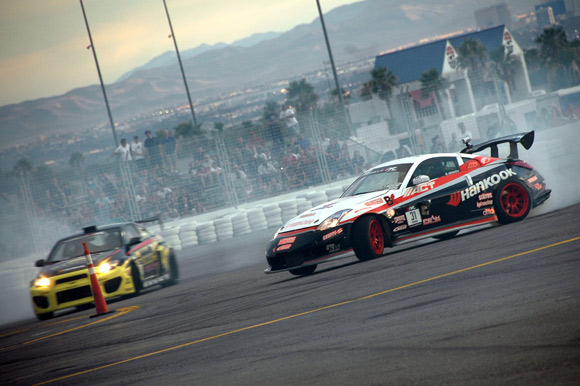
And there is good reason for it: Formula D puts on a good show. Events are run like a NCAA tournament, starting this year from the round of 32 all the way down to the head-to-head winner-take-all race. Each heat is run over a short course with four or five turns in tandem elimination runs: two cars go at a time, one car taking the lead and the other being the chase car, then the two cars go again swapping lead and chase car roles.
The criteria to take note of are the speed with which the driver navigates the course, the maximum angle of drift while still having the car under control, and the line taken through the course. The driving line is delineated by clipping points, orange cones set up at various points on the track that the drivers are meant to get as close as possible to but not touch. A speed gun is also used to measure corner entry speed and exit speed.
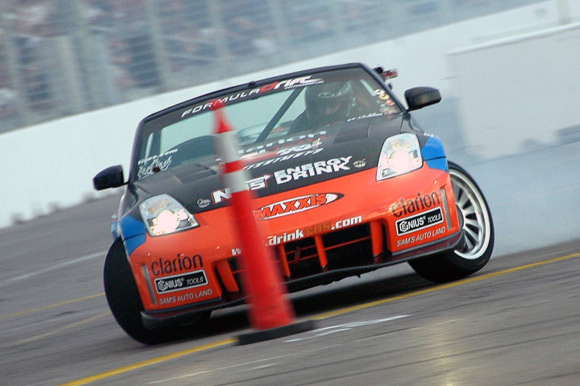
There is also an assessment given to style and impact, which, according to the official Formula D guide, are appropriately and ambiguously defined as "the excitement that each driver brings to the run," and "the 'X' factor." But we'll get to those in a moment.
Drifting is mindlessly easy to enjoy. You can see the entire track from anywhere, the turns come right after one another so you don't need to wait but three-tenths of a second for another drift to happen, and because the drivers are working to jack up their X factor the show is always turned up to 11. The cars, and especially the tires, are also tuned for the show, so we knew when we'd see one of the Falken Zs come through that we'd soon witness a smoke screen worthy of the most outrageous Bond film, and our chests would swell with warm lungs full of vulcanized vapors.
Yet the drivers have not all been created equal. The pilots in the early rounds will certainly make an impression. Nevertheless, as with the NCAA tournament, watch a top rated driver go against a much lower ranked driver and the differential is chasmal enough to make you wonder if the less accomplished wheelman really knows what he's supposed to be doing. Lay eyes on Hubinette or Foust taking on a mismatched opponent in the first of the tandem heats, and you don't even bother watching the other guy when the second heat runs – the big guns steal all thunder and all lightning.
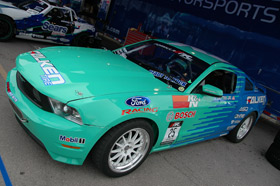
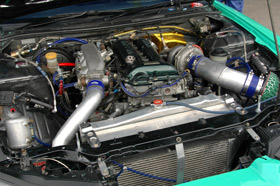
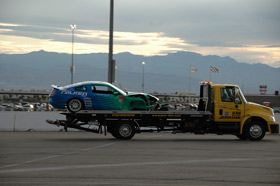
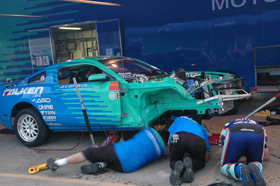
And it is immediately clear that drifting takes skill. Even that #32 guy, like the worst guy on the worst NBA team, could beat a lot of other chaps you might think very good. Autoblog got the chance to ride shotgun with Sam Hubinette, in his 800+ horsepower Viper, on a Holy-Mary-Mother-of-God drifting run around a proper track and even got to experience his signature 360 move. We can swear this under oath: drifting well takes immense ability. As far as that Hubinette run went, we're going to go with lolcats who put it best by saying, "Skillz. He haz dem."
What's it like? Shot from a cannon – not a small cannon, something large, like 16-inch dreadnought artillery – towards the first turn. Bonecrushing noise. Hit nearly 100, then, well before you reach the turn, the car flips sideways and continues down the track... sideways. Smoke fills the car. Turn your head and you can see the turn off in the distance. You're still headed for it, but you're doing so at a right angle to it. This goes on for a solid year. Get to the turn, feel rear tires bite, and then just as you think you're about to head in the direction the hood is pointed – oh, silly boy – the back end kicks out again and you're looking practically backwards, at where you just were, sliding at 40 mph through the apex and across to the opposing curb. Repeat this two more times and you learn not to even look for the turns anymore since you're going to do half the straight sideways anyway.
And the 360 was fabulous even though it happened so fast we couldn't keep track of anything but rev noises. We were going straight, and briskly at that, Hubinette see-sawed the wheel, the revs went crazy, we did the hokey-pokey and we turned ourselves around, and then we were going straight again. Ta-da!
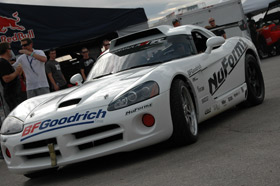
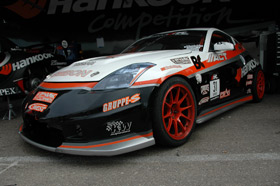
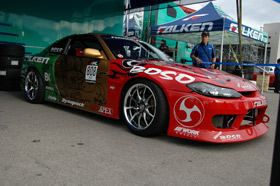
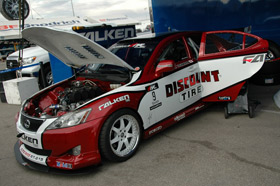
All of which is to point out, again, that these gents know what they're doing. And after all of that, Hubinette is, at the moment, third in the standings.
Skill at high horsepower is what makes Formula D like a motorsport. The reason it isn't a motorsport is because it isn't timed, it's judged. Like figure skating, and synchronized swimming. And that has opened the doors to all sorts of controversy, some of which we saw in Las Vegas.
Before the event begins, the driver briefing is held and one of the Formula D officials takes the drivers through the kind of line or lines the judges are looking for. When the racing starts, drivers are held to account for various moves that can add or take away points: a spinout results in zero points; if at least three tires go off the course the driver gets zero points; if a driver hits an inner clipping cone, at the apex of the turn, points will be deducted; if an outer clipping cone is hit with anything other than the rear bumper, the driver will gets zero points; collisions result in the responsible driver getting zero points.
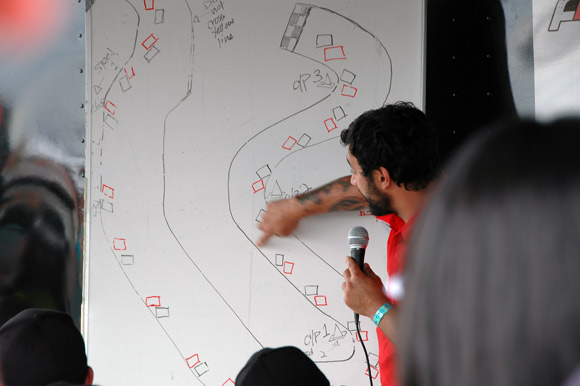
After the two runs, the three judges either vote for one of the drivers, or for "One more time" (OMT) if a heat was too close to call. The OMT option can be used twice, after which the judges must vote for one of the drivers. It can be exciting if you get one of the two top drivers in an OMT battle, but when the lower-ranked pilots have to go twice more it can take a viewer out of the match, especially when it's 110 degrees.
Because advancing relies on humans and not impartial circuit boards, there are incidents that can lead a viewer to wonder what the judges were looking at. If the following car collides into the lead car and takes the leader off his line, the following car is meant to get zero points. That means that in the next run, the following car – who was the injured leader in the first run – should only need to make a mistake-free drive in order to advance. That isn't always what happens. In the round of 32 we saw one run where the following car went so hot into the second turn that the two cars ended up alongside each other, going through their drift like conjoined twins. The second run was incident free, but the following car from the first run went through.
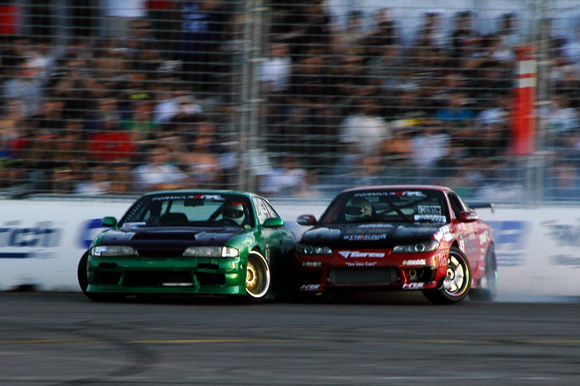
There was a similar and much more questionable incident with Sam Hubinette later on. Hubinette was the lead car in a heat against Ryuji Miki, and Miki's front wheel hit Hubinette's Viper hard enough to leave a healthy black blotch on Hubinette's door and quarter panel. Hubinette kept the car going, didn't spin, and then executed a flawless run as the following car. The elimination round went to Miki, and Hubinette's night was over. Spectators saw the contact, and many thought it was egregious enough to still be speaking about it the next day. Several people told us "Sam should have spun." It would then have been a clear issue about who should have advanced. But that didn't happen, and that's just how it goes.
Even the composition of the judging panel has its detractors. Chris Forsberg is a senior member of a team called Drift Alliance, and it also happens that one of the Formula Drift judges, Tony Angelo, is a senior member of Drift Alliance. So are Formula D drivers Vaughn Gittin, Jr. and Ryan Tuerck. Forsberg entered round four in third place and left in the lead in the Formula D standings; Tuerck started and finished in second, Gittin, Jr. gained a place, moving from fifth to fourth. That puts three of the four senior Formula Alliance members in the top four places of the standings – the fourth member of the Alliance being a Formula D judge.
That isn't necessarily a smoking gun. But it is difficult to plead true impartiality when a team member is judging other team members in close situations. It was also telling that no one we spoke to would go on the record when discussing issues like this in Formula D. They couldn't risk it – judges, unlike clocks, read and remember things.
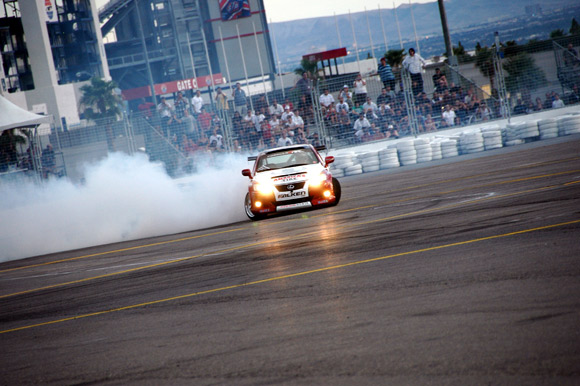
This does not, however, damn the enterprise, because the promise of howling clouds of rubber is well and truly delivered. (And on a side note, rumor is that D1 GP's judging incidents have been far more dubious.) And none of this takes away from Formula D as exceptionally highly skilled entertainment – and it is definitively entertaining. And we don't mean entertainment like wrestling – there isn't any Vince McMahon-like overlord controlling drivers in order to create a show. For us, though, it simply isn't a motorsport. It is smoke and squealing and anger and drivers going all out, and sideways at that, to win the cup.
And that's fine. Because they sure know to show you a good time. Even in the heat of ten thousand suns.
Photos Copyright ©2009 Jonathon R. Ramsey / Weblogs, Inc.
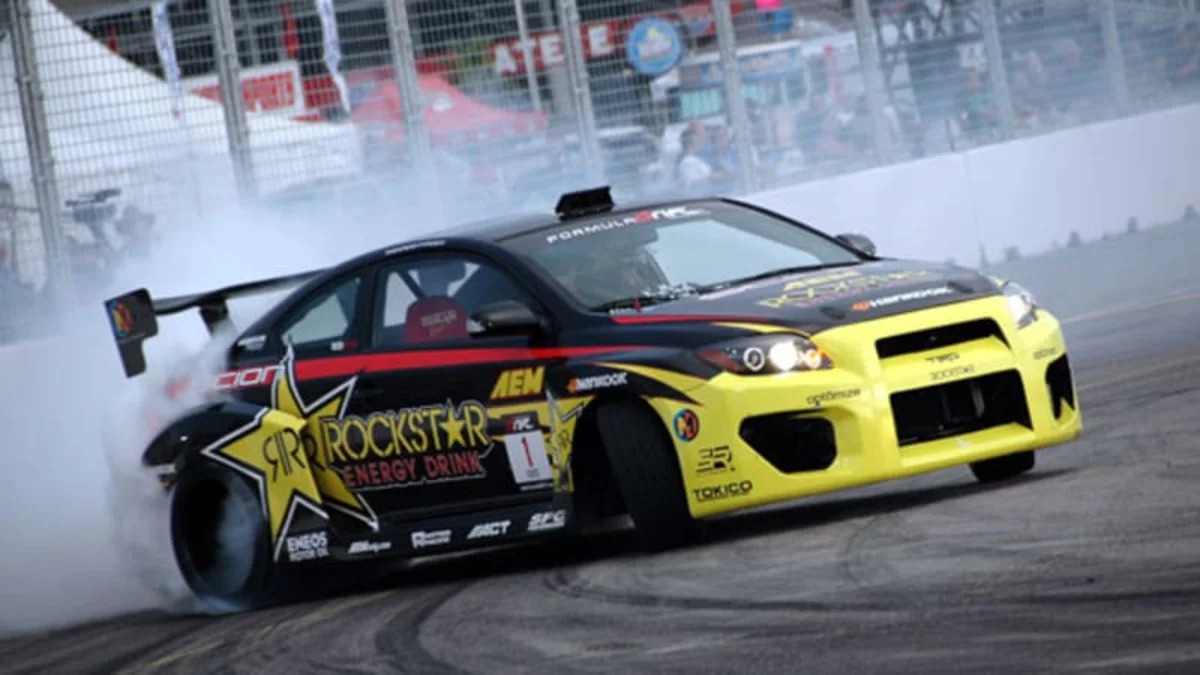
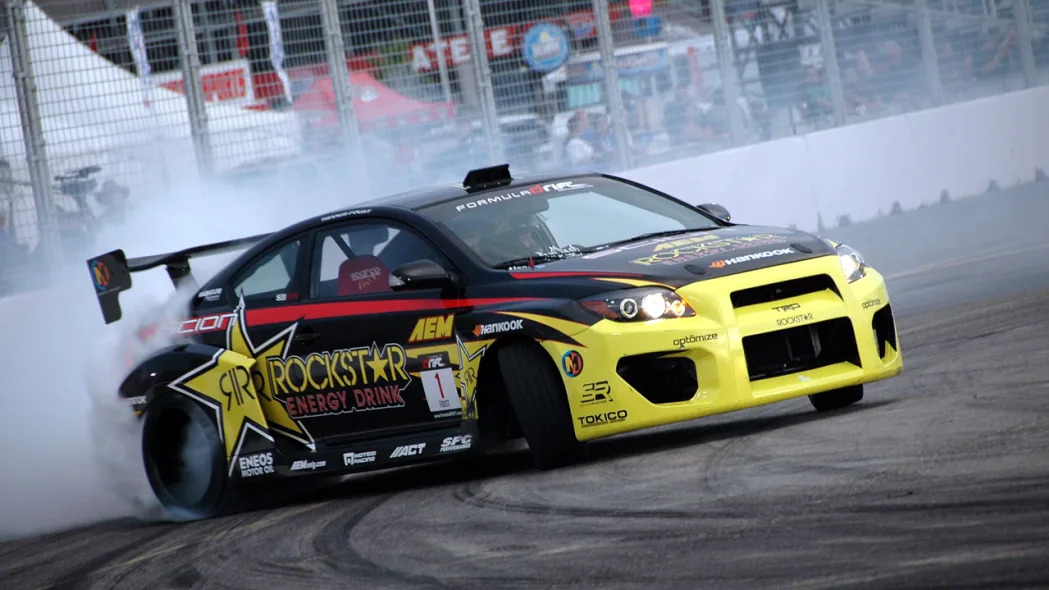

Sign in to post
Please sign in to leave a comment.
Continue